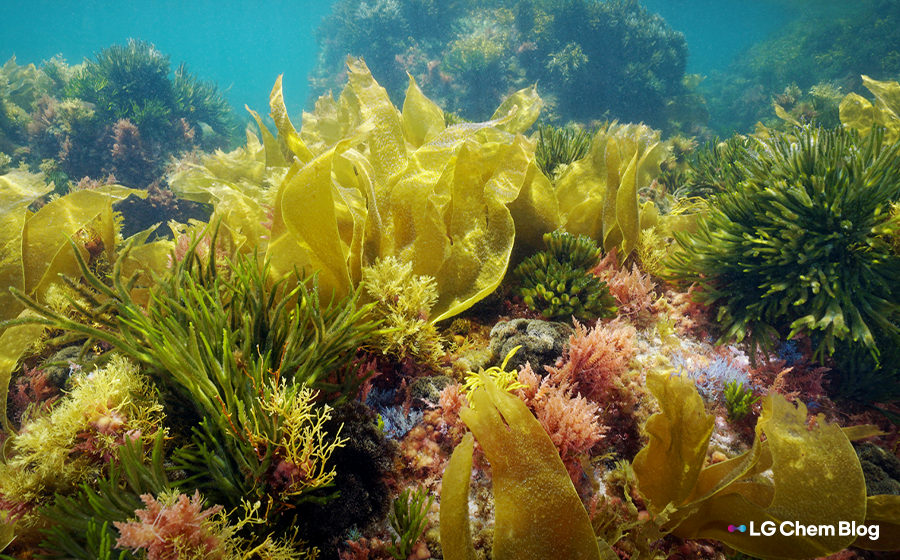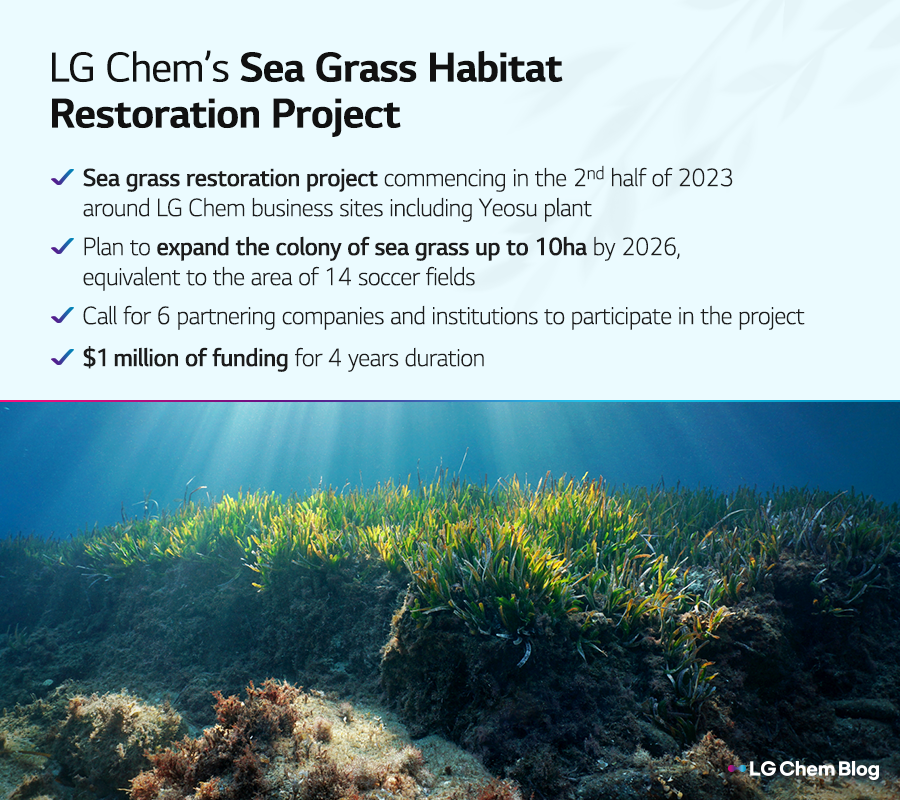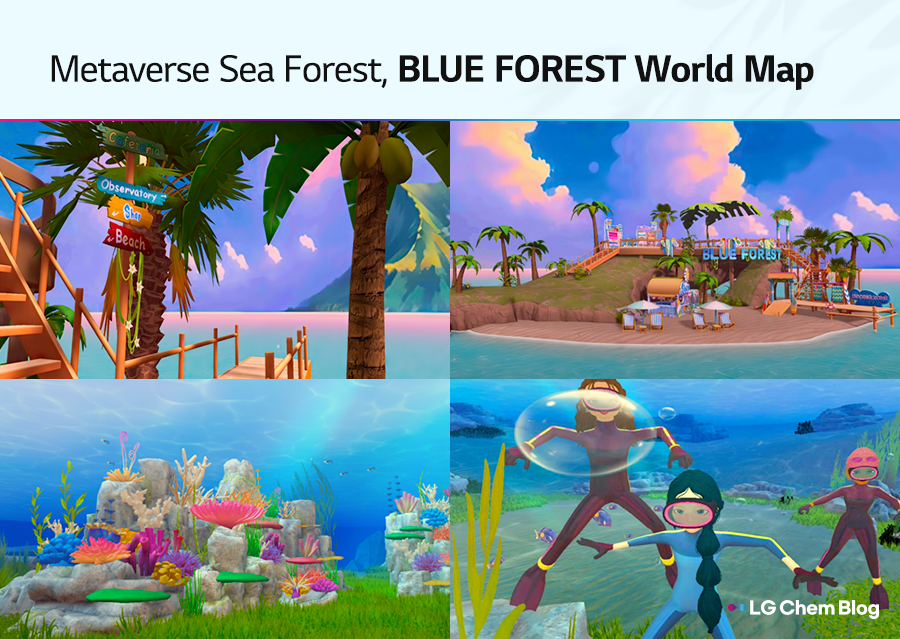Sea grass, a solution to sea desertification or bleaching by absorbing greenhouse gases! LG Chem restores sea forest with sea grass to build a sustainable future
2023. 07. 21
2023. 07. 21
Have you seen ‘sea grass,’ a type of a marine plant? Out of all ocean plants and algae, sea grass is drawing public attention as a measure of ‘sea-forest restoration.’ Learn about sea grass that absorbs greenhouse gases and how LG Chem makes use of the plant to restore the sea forest.
Abnormal climates such as heat waves and tropical nights make frequent news headlines in summer. One major cause of this climate change is the greenhouse gas. As the nature, which used to absorb a tremendous amount of greenhouse gas, becomes more and more destructed, abnormal climates and global warming are striking the Earth more severely.

Forests, soil, ocean, and wetlands have played significant roles in absorbing or trapping the greenhouse gas emitted from human activities to create a balance in the carbon cycle. Ocean, specifically the ocean forest, has been the key player which absorbs carbon dioxide through photosynthesis. It boasts 50 times the speed and 5 times the capacity of holding carbon dioxide compared to forests on land, dealing with a tremendous amount of greenhouse gases on Earth. However, for the past 200 years, industrialization and urbanization have destroyed a large portion of the sea forest, and failing to absorb greenhouse gases is accelerating the climate crisis.
On top of that, various contaminants including waste water is also threatening the sea forest. This causes destruction in the ocean, the source of our life, accompanying the phenomenon of ‘sea desertification.’ What image comes to your mind when you think of the word ‘desert?’ You would probably imagine a sand desert without a drop of water. How then, can the sea full of water become a desert?

The more common term for ‘bleaching’ is the ‘sea desertification.’ Pollution in the ocean and global warming lead to a rise in sea temperature, causing calcium carbonate (lime powder) to stick to marine creatures, floors, and rocks, turning them white. This phenomenon was massively discovered around the globe after the 1960s, such as in the coast of Northwestern Norway, California Pen, Western and Eastern Canada, Australia in the South Pacific, the Red Sea, and Japan.
How does bleaching affect the marine ecosystem? Bleaching makes calcium carbonate stick to the ocean floors and rocks, causing alkalization of the sea water. This creates a harsh environment for ocean plants to survive in, as their photosynthesis takes place under a neutral condition. Ocean plants are the foundation of sea forest in that they create nutriments and become the primary food source for marine animals. The destruction of natural rocks means that these plants will lose their habitats and start to wither. Then, the ocean floor will become devastated like the desert. The question is, how can we reduce bleaching and protect the sea forest?
We plant trees to restore our land from deforestation. In the same way, to restore the ocean forest requires planting ocean plants and algae. Seaweed, sea grass, and gulfweed are types of plants that can help restore the coastal ecosystem. Among these, sea grass is at the center of attention.
Sea grass is a type of a seaweed that blooms underwater. Gaining public attention as ‘Blue carbon,’ it is a home for marine animals as well as an effective absorbent of carbon. A colony of sea grass, including the sedimentary layer, can absorb about 300~500 tons of carbon per 1ha (10,000㎡). This is 500 tons of carbon per 10ha, which is equivalent to the annual amount of carbon emitted by 2,800 automobiles. Sea grass has proven its capacity to absorb 30 times the amount of greenhouse gas than forests, which is why the UN IPCC (The Intergovernmental Panel on Climate Change) listed sea grass as one of the Top 3 blue carbons (carbon absorbed by the marine ecosystem).
*Maximum 500 tons of carbon absorption per 1ha (10,000㎡) of sea grass colony including sedimentary layers (Source: Incheon Natl. University Research Team Led by Prof. Kim Jangkyoon)

With LG Chem’s major business sites situated in the coastal cities of Yeosu and Daesan in Korea, the company keeps keen interest in the ocean. For instance, LG Chem’s ‘sea grass habitat restoration and research project’ aims to protect the marine ecosystem and preserve biodiversity. In the 2nd half of 2023, LG Chem plans to select sites around their plants including Yeosu to commence the sea grass habitat restoration project. The company targets at expanding the colony of sea grass up to 10ha by 2026, which is equivalent to the area of 14 soccer fields. With LG Chem taking the initiative, 6 companies and institutions have signed to take part in this project, followed by LG Chem’s plan to fund the project with a total of $1 million (KRW 1.4 billion).
Recently, there is a global threat on the colonies of sea grass due to global warming and ocean trash, raising the importance of restoring and researching the sea grass ecosystem. Given that we succeed in restoring the sea forest through sea grass, the benefit is not limited to absorbing more carbon. The population of marine animals inhabiting the area will rise by 2.5 times, types of species by 1.5 times, and biodiversity index by 1.2 times. With improved water quality and restoration in the ecosystem, we can look to various positive impacts on the coexistence with nearby fishing villages and carbon reduction.

On June 8th 2023, LG Chem commemorated World Oceans Day by opening a ‘BLUE FOREST’ world map on Zepeto, a global metaverse platform. BLUE FOREST is a virtual space where users can experience the sea forest without having to jump into the sea. The map offers diverse activities such as planting sea grass, volunteering for Ocean Arbor Day, etc. Here on this map, anyone can create his/her own sea forest, conduct different missions, and play games while learning about the carbon reduction effect and importance of preserving the marine ecosystem. In just 1 month of launch, BLUE FOREST recorded over 1 million users. Most users are in their teens and 20s, and it has been analyzed that stay an average of 10 minutes on the metaverse, leaving more than 100,000 reviews on the first month. It is assumed that the interaction with users such as planting sea grass, cultivating the sea forest (Level up), and summoning the marine animals had positive effect on its success. LG Chem also carries out a donation event to celebrate receiving 1 million visitors and 1 month since the launching of BLUE FOREST.
LG Chem has a passion to fulfill their social responsibility as a global science company and do their best to restore the sea forest. We can look forward to a healthier marine ecosystem and biodiversity in the coast of Yeosu through restoring the sea grass habitats. LG Chem will not stop there, and continue their steps towards sustainable growth with the future generations.

There are no comments yet! Be the first to let us know your thoughts!